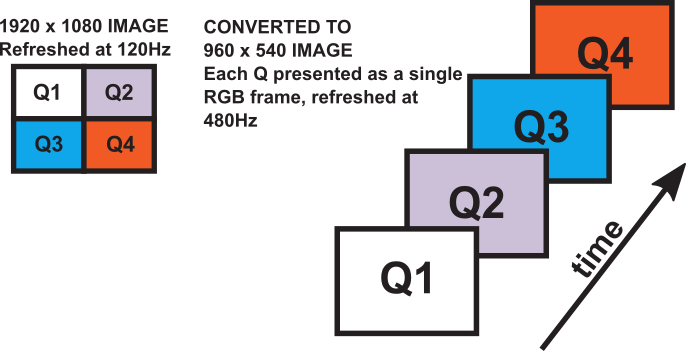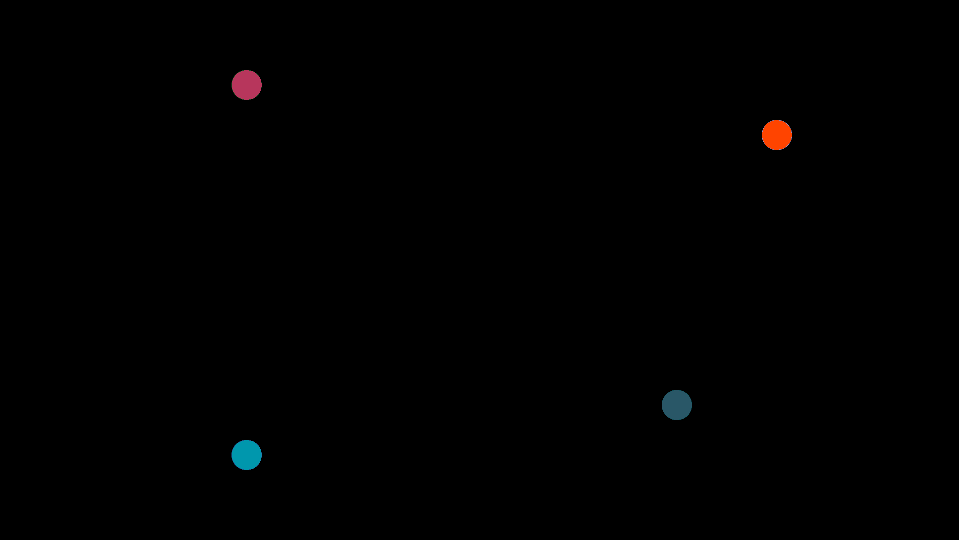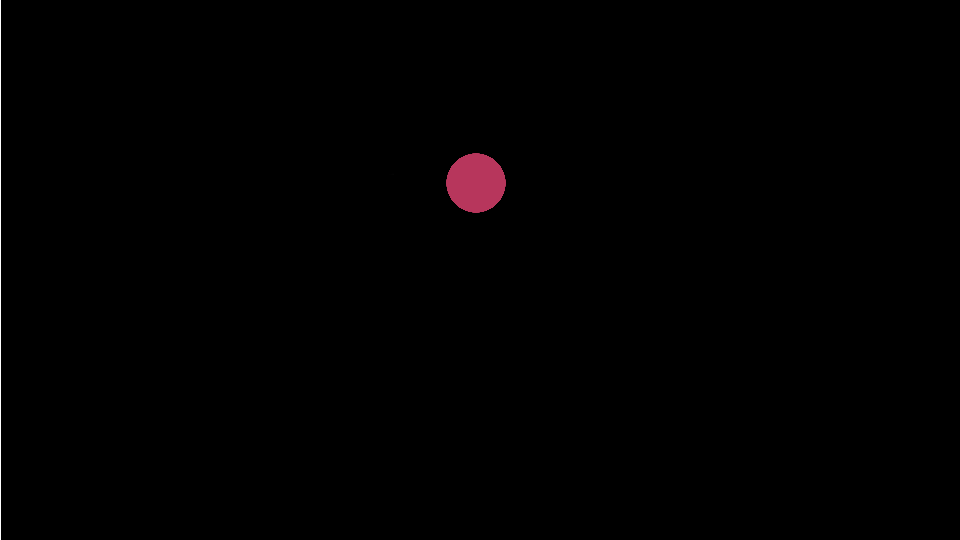PROPixx Demo 1 – Drawing dots at 480 Hz¶
This demo is a simple demonstration of the PROPixx’s 480 Hz sequencer. We show four random-color dots around the center of the screen, cycling at a rate of 480 Hz. The demo ends when a key is pressed.
Currently, there is no graphics card capable of drawing individual frames at 480 Hz. In order to achieve this refresh rate, the PROPixx uses a built-in “sequencer” that takes a 1920 x 1080, 120 Hz video signal and breaks it into multiple frames which are then displayed in sequence. In 480 Hz mode, we divide the 1920 x 1080 image into four full color 960 x 540 images, or “quadrants” and show these in a sequence starting with the top left quadrant. All quadrants are displayed full-screen.

To create our stimuli, we draw our targets as if they were full resolution, full screen. The helper script convertToQuadrant reassigns and rescales the target positon to the correct quadrant. A screen running in 120 Hz mode will show the four quadrants drawn on the same frame:

The PROPixx in 480 Hz mode will display the four quadrants in sequence:

1 2 3 4 5 6 7 8 9 10 11 12 13 14 15 16 17 18 19 20 21 22 23 24 25 26 27 28 29 30 31 32 33 34 35 36 37 38 39 40 41 42 43 44 45 46 47 48 49 50 51 52 53 54 55 56 57 58 59 60 61 62 63 64 65 66 67 68 69 70 71 72 73 74 75 76 77 78 79 80 81 82 83 84 85 86 87 88 89 90 91 92 93 94 95 96 97 98 99 100 101 102 103 104 105 106 107 108 109 110 111 112 113 114 115 116 117 118 119 120 121 122 123 124 125 126 127 128 129 130 131 132 133 134 135 | function PPxDraw480HzDots
%This function draws a series of dots around the center of the
%display at 480 Hz.
% First, we construct a single 1920 x 1080 RGB image, which is passed to
% the PROPixx. The sequencer breaks the image down and shows the quadrants
% as 4 individual 960 x 540 frames, one after the other.
%_______________________________
%| | |
%| Q1 | Q2 |
%| | |
%|_____________|________________|
%| | |
%| Q3 | Q4 |
%| | |
%|_____________|________________|
%Quadrants are shown FULL SCREEN, RGB in the order Q1-Q2-Q3-Q4.
% To create stimuli, we draw our targets as if they were full resolution,
% full screen. The helper script 'convertToQuadrant' reassigns and rescales
% the target positon to the correct quadrant. Remember that each quadrant
% gets blown up to full screen, so your resolution will be halved
% vertically and horizontally.
% Made and tested with:
% -- PROPixx firmware revision 43
% -- DATAPixx3 firmware revision 19
% -- MATLAB version 9.6.0.1150989 (R2019a)
% -- Psychtoolbox version 3.0.15
% -- Datapixx Toolbox version 3.7.5735
% -- Windows 10 version 1903, 64bit
% Sep 27 2019 lef written
% Mar 26 2020 lef revised
%Check connection and open Datapixx if it's not open yet
isConnected = Datapixx('isReady');
if ~isConnected
Datapixx('Open');
end
Datapixx('SetPropixxDlpSequenceProgram', 2); %Set Propixx to 480Hz refresh (also known as Quad4x)
Datapixx('RegWrRd'); %Push command to device register
%Open a display on the Propixx
AssertOpenGL;
KbName('UnifyKeyNames')
Screen('Preference', 'SkipSyncTests', 1);
screenID = 2; %Change this value to change display
[windowPtr,rect] = PsychImaging('OpenWindow', screenID, 0);
%Set up some stimulus characteristics
dotRadius = 30;
%Create some positions based on the regular display
center = [rect(3)/2, rect(4)/2];
radius = 200;
positions=[center(1), center(2)-radius;... %top
center(1)+radius, center(2);... %right
center(1), center(2)+radius;... %bottom
center(1)-radius, center(2)]; %left
%Start displaying dots
while 1
%Above center, random colour
quadrant = 1;
position = positions(1, :);
colour = round(rand([1,3])*255);
%Convert position to the same position in the quadrant 1 and draw
[x,y] = convertToQuadrant(position, rect, quadrant);
Screen('FillOval', windowPtr, colour, [x-dotRadius, y-dotRadius, x+dotRadius, y+dotRadius]);
%Right of center, random colour
quadrant = 2;
position = positions(2, :);
colour = round(rand([1,3])*255);
%Convert position to the same position in the quadrant 2 and draw
[x,y] = convertToQuadrant(position, rect, quadrant);
Screen('FillOval', windowPtr, colour, [x-dotRadius, y-dotRadius, x+dotRadius, y+dotRadius]);
%Below center, random colour
quadrant = 3;
position = positions(3, :);
colour = round(rand([1,3])*255);
%Convert position to the same position in the quadrant 3 and draw
[x,y] = convertToQuadrant(position, rect, quadrant);
Screen('FillOval', windowPtr, colour, [x-dotRadius, y-dotRadius, x+dotRadius, y+dotRadius]);
%Left of center, random colour
quadrant = 4;
position = positions(4, :);
colour = round(rand([1,3])*255);
%Convert position to the same position in the quadrant 4 and draw
[x,y] = convertToQuadrant(position, rect, quadrant);
Screen('FillOval', windowPtr, colour, [x-dotRadius, y-dotRadius, x+dotRadius, y+dotRadius]);
%Flip
Screen('Flip',windowPtr);
%Keypress to exit
[keyIsDown, ~, ~, ~] = KbCheck;
if keyIsDown
break
end
end
Screen('Closeall');
Datapixx('SetPropixxDlpSequenceProgram', 0); %Revert to standard 120Hz refresh rate
Datapixx('RegWrRd');
Datapixx('Close');
end
function [x,y] = convertToQuadrant(position, displaySize, quad)
%This scales an x, y position into a specific quadrant of the screen
scale = 0.5;
switch quad
case 1; xOffset = 0; yOffset = 0;
case 2; xOffset = displaySize(3)/2; yOffset = 0;
case 3; xOffset = 0; yOffset = displaySize(4)/2;
case 4; xOffset = displaySize(3)/2; yOffset = displaySize(4)/2;
end
x = (position(1)*scale)+xOffset;
y = (position(2)*scale)+yOffset;
end
|